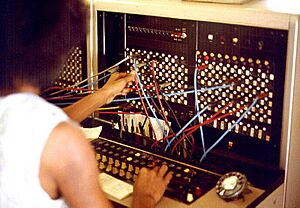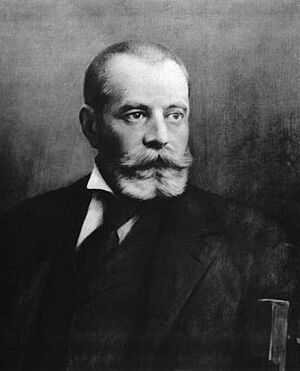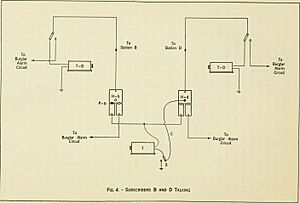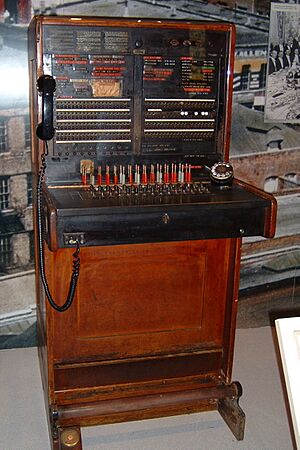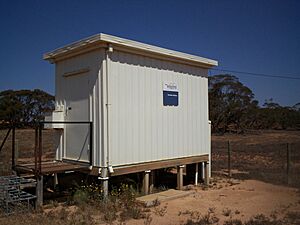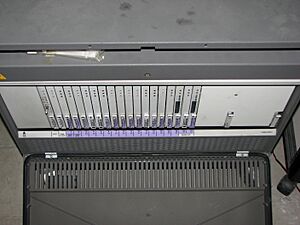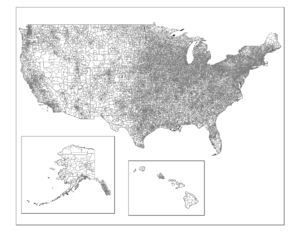Telephone exchange facts for kids
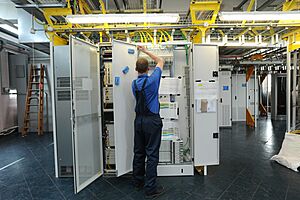
A telephone exchange is a very important part of how phones connect. It's also called a telephone switch or central office. It helps connect your phone line to other phone lines, allowing you to make telephone calls to people far away or even just down the street.
Over time, the words used for these places have changed. "Telephone exchange" and "central office" often mean the same thing. A central office is usually the building where the equipment for one or more telephone exchanges is kept. Each exchange serves a certain area, sometimes called an "exchange area." In North America, a "wire center" is another name for a central office, meaning it's where your phone gets its dial tone.
In the 1940s, a new system was set up in the United States and Canada. It gave each central office a special three-digit code. This code, along with an "area code," made sure every central office had a unique number. These codes became the first few numbers in a phone number. Other countries also worked to organize their phone networks, especially as people started making international calls.
For businesses, there's a special type of telephone exchange called a private branch exchange (PBX). This system connects all the phones within a company and also links them to the main public phone network. You'll often find PBXs in large offices or company campuses. Smaller businesses might use a simpler PBX or a key telephone system managed by a receptionist.
Contents
How Telephones Started
Before telephone exchanges, early telephones could only connect to one other phone. Imagine if your home phone could only call your best friend's house, and no one else! This made telephones not very useful for many people.
A telephone exchange changed everything. It was a system for a small area that could connect many phone lines together. This meant you could call anyone connected to that exchange. Exchanges made using a telephone easy and helped create a whole new industry.
Many people claim to have invented the first telephone exchange. One of the first to suggest the idea was Hungarian Tivadar Puskás in 1877. The first test exchange, based on Puskás's ideas, was built by the Bell Telephone Company in Boston in 1877. The world's first government-run exchange opened in Berlin in 1877.
George Willard Coy built the first commercial exchange in the US. It opened in New Haven, Connecticut in January 1878. This early switchboard was made from simple items like "carriage bolts, handles from teapot lids and bustle wire." It could handle two calls at the same time.
Manual Telephone Exchanges
In the early days, telephone exchanges were run by people called switchboard operators. When you wanted to make a call, you would pick up your phone. This would light up a small lamp on the operator's switchboard. The operator would then plug a cord into your line and ask, "Number, please?"
If the person you wanted to call was in the same office, the operator would plug another cord into their line. Then they would make the other phone ring. For calls to a different city, the operator would connect to another operator in that city. In 1918, it took about 15 minutes to connect a long-distance call!
Over time, switchboards got better. Operators no longer had to manually ring the other phone. The system would do it automatically once the operator plugged in the cord. This freed up the operator to help more people.
In some rural areas, phones used a crank to make a signal. You would turn the crank to alert the operator or another person on your line. These systems often had "party lines," where several homes shared one phone line. Everyone on the line could hear the signals, and sometimes even listen to other people's conversations!
Automatic Telephone Exchanges
Automatic exchanges were a big step forward. They were invented by Almon Strowger in 1888. These systems removed the need for human operators to connect calls. Instead, phones got a dial. You would dial the numbers, and the machine would connect your call.
When you pick up your phone, the exchange knows you want to make a call. It then gives you a dial tone to show it's ready. As you dial, the exchange understands the numbers and connects you to the right phone. This can be a phone in the same building or one far away.
The exchange keeps the connection going until one of you hangs up. This is called "supervision." Automatic exchanges also helped with things like billing and special services like toll-free 800-numbers.
Early automatic exchanges used mechanical parts like motors, spinning switches, and relays. Some common types were the Strowger switch (also called a step-by-step switch) and the crossbar switch. These systems were quite noisy and needed a lot of care. Technicians had to clean them and fix parts often.
Electronic and Digital Switches
Over time, telephone switches became more advanced. They went from mechanical systems to electronic and then fully digital systems. Early electronic systems still used some mechanical parts but were controlled by computers. This made testing equipment and changing phone numbers much easier.
Digital switches are what we mostly use today. They were first developed in the 1930s, but the first commercial digital exchange started serving customers in France in 1972.
When you talk on a digital phone system, your voice is turned into digital information (like computer data) 8,000 times every second. This digital information is then sent to the other phone, where it's turned back into sound. This happens so fast that you barely notice any delay.
Many individual phone lines connect to a device called a remote concentrator. These concentrators are often in the same building as the switch or in a neighborhood far from the main office. They are used because most phones are not in use all the time. So, the calls from many phones can be "concentrated" onto fewer shared connections, saving money.
Some telephone switches don't connect directly to homes. Instead, they connect calls between other telephone switches. These are called "carrier-level" or tandem switches. They handle long-distance calls between different cities or regions.
How Switches Are Designed
Telephone switches are built to be very reliable. They often have many layers of smaller, simpler switches. If one small part of the switch breaks, the main computer knows about it. It then stops sending new calls through that broken part, but calls already connected keep working. This way, the broken part can be fixed without stopping everyone's calls.
To make sure you don't keep getting a bad connection, switches are designed so that if you hang up and call again, you'll likely get a different path through the switch. This helps avoid repeated problems with the same faulty connection.
Connecting to the Network
Telephone switches are just one part of a huge network. A big part of this network is the "outside plant," which includes all the wires and cables outside the central office building. Each home or business usually has its own pair of wires connecting to the switching system.
Inside a central office, there can be tens of thousands of wire pairs connected to special panels called the main distribution frame (MDF). This panel also has safety devices like fuses to protect the switch from lightning or power line issues.
To save money on wires, some companies use "pair gain" devices or digital loop carriers (DLCs). These devices are placed in neighborhoods far from the central office. They allow many phone lines to share a single digital connection back to the main switch. This also helps provide faster internet services like digital subscriber line (DSL) because the copper wires from your home to the DLC are shorter.
There are two main types of switches in the public phone network:
- Class 4 telephone switches are for long-distance calls, connecting one switch to another.
- Class 5 telephone switches (or subscriber switches) manage connections from individual phones.
Since the 1990s, many switches can do both jobs.
The entire telephone network relies on very accurate timing. All the switching, sending, and billing equipment needs to be perfectly synchronized. This is often done using very precise clocks, sometimes even linked to GPS satellites.
Images for kids
See also
- History of telecommunication
- List of telephone switches
- Softswitch
- Telephone exchange names


